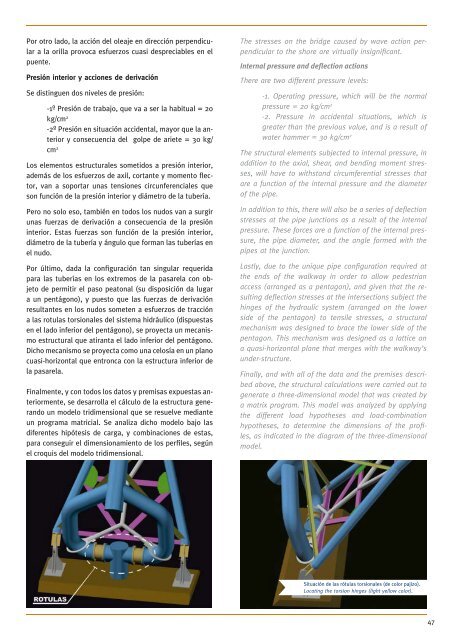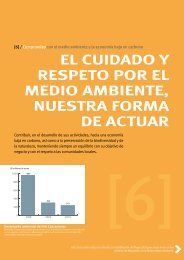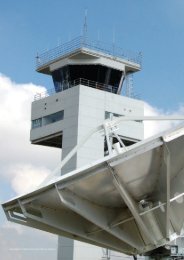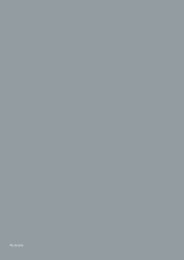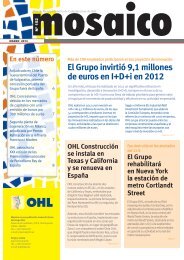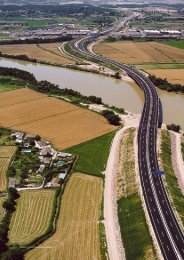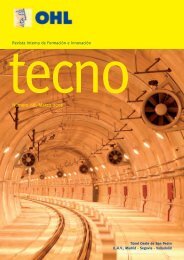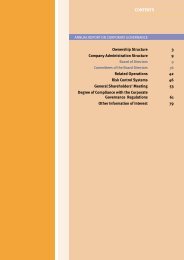Nº 84, Septiembre/September 2012 - Ohl
Nº 84, Septiembre/September 2012 - Ohl
Nº 84, Septiembre/September 2012 - Ohl
You also want an ePaper? Increase the reach of your titles
YUMPU automatically turns print PDFs into web optimized ePapers that Google loves.
Por otro lado, la acción del oleaje en dirección perpendicular<br />
a la orilla provoca esfuerzos cuasi despreciables en el<br />
puente.<br />
Presión interior y acciones de derivación<br />
Se distinguen dos niveles de presión:<br />
-1º Presión de trabajo, que va a ser la habitual = 20<br />
kg/cm 2<br />
-2º Presión en situación accidental, mayor que la anterior<br />
y consecuencia del golpe de ariete = 30 kg/<br />
cm 2<br />
Los elementos estructurales sometidos a presión interior,<br />
además de los esfuerzos de axil, cortante y momento flector,<br />
van a soportar unas tensiones circunferenciales que<br />
son función de la presión interior y diámetro de la tubería.<br />
Pero no solo eso, también en todos los nudos van a surgir<br />
unas fuerzas de derivación a consecuencia de la presión<br />
interior. Estas fuerzas son función de la presión interior,<br />
diámetro de la tubería y ángulo que forman las tuberías en<br />
el nudo.<br />
Por último, dada la configuración tan singular requerida<br />
para las tuberías en los extremos de la pasarela con objeto<br />
de permitir el paso peatonal (su disposición da lugar<br />
a un pentágono), y puesto que las fuerzas de derivación<br />
resultantes en los nudos someten a esfuerzos de tracción<br />
a las rotulas torsionales del sistema hidráulico (dispuestas<br />
en el lado inferior del pentágono), se proyecta un mecanismo<br />
estructural que atiranta el lado inferior del pentágono.<br />
Dicho mecanismo se proyecta como una celosía en un plano<br />
cuasi-horizontal que entronca con la estructura inferior de<br />
la pasarela.<br />
Finalmente, y con todos los datos y premisas expuestas anteriormente,<br />
se desarrolla el cálculo de la estructura generando<br />
un modelo tridimensional que se resuelve mediante<br />
un programa matricial. Se analiza dicho modelo bajo las<br />
diferentes hipótesis de carga, y combinaciones de estas,<br />
para conseguir el dimensionamiento de los perfiles, según<br />
el croquis del modelo tridimensional.<br />
The stresses on the bridge caused by wave action perpendicular<br />
to the shore are virtually insignificant.<br />
Internal pressure and deflection actions<br />
There are two different pressure levels:<br />
-1. Operating pressure, which will be the normal<br />
pressure = 20 kg/cm 2<br />
-2. Pressure in accidental situations, which is<br />
greater than the previous value, and is a result of<br />
water hammer = 30 kg/cm 2<br />
The structural elements subjected to internal pressure, in<br />
addition to the axial, shear, and bending moment stresses,<br />
will have to withstand circumferential stresses that<br />
are a function of the internal pressure and the diameter<br />
of the pipe.<br />
In addition to this, there will also be a series of deflection<br />
stresses at the pipe junctions as a result of the internal<br />
pressure. These forces are a function of the internal pressure,<br />
the pipe diameter, and the angle formed with the<br />
pipes at the junction.<br />
Lastly, due to the unique pipe configuration required at<br />
the ends of the walkway in order to allow pedestrian<br />
access (arranged as a pentagon), and given that the resulting<br />
deflection stresses at the intersections subject the<br />
hinges of the hydraulic system (arranged on the lower<br />
side of the pentagon) to tensile stresses, a structural<br />
mechanism was designed to brace the lower side of the<br />
pentagon. This mechanism was designed as a lattice on<br />
a quasi-horizontal plane that merges with the walkway’s<br />
under-structure.<br />
Finally, and with all of the data and the premises described<br />
above, the structural calculations were carried out to<br />
generate a three-dimensional model that was created by<br />
a matrix program. This model was analyzed by applying<br />
the different load hypotheses and load-combination<br />
hypotheses, to determine the dimensions of the profiles,<br />
as indicated in the diagram of the three-dimensional<br />
model.<br />
Situación de las rótulas torsionales (de color pajizo).<br />
Locating the torsion hinges (light yellow color).<br />
47


